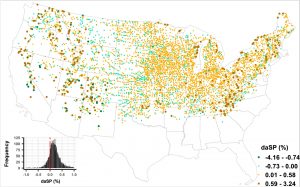
A new study from researchers at The University of Alabama showing the influence of urbanization on snow precipitation across the United States has been published in the journal Nature Communications.
It is widely known that snow precipitation is crucial for supporting water resources for more than 1.5 billion people worldwide. This study sheds light on how snow precipitation may get impacted by urbanization.
The study, authored by Drs. Kaustubh Salvi and Mukesh Kumar, finds snowfall events in urbanized areas are less frequent and probable than in nearby rural areas. The contrast is linked to differences in the fraction of solar radiation reflected by the surface of these regions.
However, the study finds no significant difference in snow precipitation in urbanized and rural areas, largely because urban areas receive more intensive snowfall events.
The study also reveals a rapid decline in the frequency and probability of snow-dominated precipitation in urban areas over time compared to their rural counterparts.
Precipitation in urban areas often has broad impacts. From affecting road safety and traffic mobility to vulnerability to severe weather events and water quality, the findings are important for remaining proactive in assessing and mitigating the consequences of urban expansion on snow patterns.
“Findings of this study have far-reaching implications for society,” said Kumar, Alabama Water Institute affiliate and associate professor of hydrology and water resources in UA’s Department of Civil, Construction and Environmental Engineering. “Changes in rain versus snow fraction with urbanization could disrupt water availability by altering the timing of runoff, potentially needing adaptation to reduce impacts on agriculture, industry and households.”
Though these changes in increased rainfall may reduce the need for snow removal and treatment of roads and decrease snowy weather-related accidents and maintenance costs, Kumar warns it may also increase flood risks and drive up insurance premiums.
“It is noteworthy that current flood risk assessment on infrastructure completely overlooks the indirect effects of urbanization on precipitation,” he said. “This study emphasizes the necessity for integrating such considerations in infrastructure design to mitigate flood vulnerability.”
“This study is the first at a continental scale over the U.S. to assess the effects of urbanization on snowfall characteristics,” said Salvi, UA postdoctoral researcher and AWI affiliate. “These changes are likely to significantly impact infrastructure and environmental sustainability unless informed mitigation policies are devised.”
